Uber's Marketing Strategy: An In-Depth Analysis of Key Concepts
VerifiedAdded on 2023/04/20
|18
|5854
|382
Report
AI Summary
This report provides a comprehensive analysis of Uber's marketing strategies and concepts. It covers the marketing mix (4Ps and 7Cs), differentiation and competitive advantage, commoditization, segmentation, managing the service element, experimental marketing, internet marketing, pricing and cost structure, branding, and sustainability (TBL and stakeholders). The report examines how Uber utilizes these concepts to maintain its market position and address challenges in the transportation industry. It also explores Uber's use of technology, customer relationship management, and various pricing strategies to enhance its competitive edge. The analysis concludes with insights into Uber's sustainability efforts and stakeholder engagement.
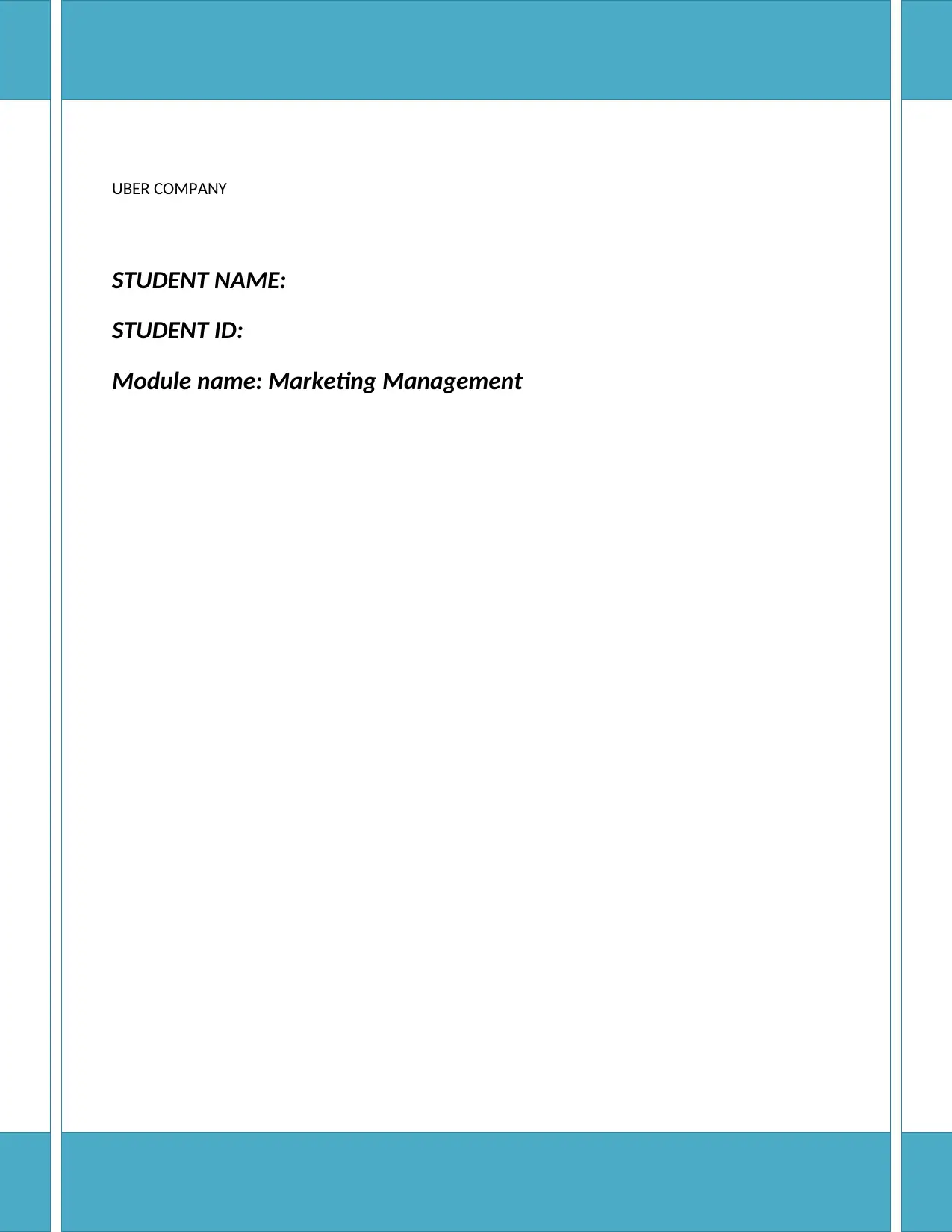
UBER COMPANY
STUDENT NAME:
STUDENT ID:
Module name: Marketing Management
STUDENT NAME:
STUDENT ID:
Module name: Marketing Management
Paraphrase This Document
Need a fresh take? Get an instant paraphrase of this document with our AI Paraphraser

UBER
Table of Contents
Introduction.................................................................................................................................................2
Marketing Mix P’s.......................................................................................................................................2
UBER 7 C’s in marketing mix.....................................................................................................................4
Differentiation and competitive advantage..................................................................................................6
Commoditization and total product & solution offering..............................................................................6
Segmentation...............................................................................................................................................6
Managing the service element.....................................................................................................................7
Experimental marketing: Customer relations and Experience management................................................7
Use of Internet in Marketing........................................................................................................................8
Pricing and Cost Structure...........................................................................................................................9
Branding....................................................................................................................................................10
Sustainability, TBL and Stakeholders........................................................................................................11
Triple bottom line......................................................................................................................................11
Stakeholders..............................................................................................................................................11
Conclusion.................................................................................................................................................12
References.................................................................................................................................................13
2
Table of Contents
Introduction.................................................................................................................................................2
Marketing Mix P’s.......................................................................................................................................2
UBER 7 C’s in marketing mix.....................................................................................................................4
Differentiation and competitive advantage..................................................................................................6
Commoditization and total product & solution offering..............................................................................6
Segmentation...............................................................................................................................................6
Managing the service element.....................................................................................................................7
Experimental marketing: Customer relations and Experience management................................................7
Use of Internet in Marketing........................................................................................................................8
Pricing and Cost Structure...........................................................................................................................9
Branding....................................................................................................................................................10
Sustainability, TBL and Stakeholders........................................................................................................11
Triple bottom line......................................................................................................................................11
Stakeholders..............................................................................................................................................11
Conclusion.................................................................................................................................................12
References.................................................................................................................................................13
2
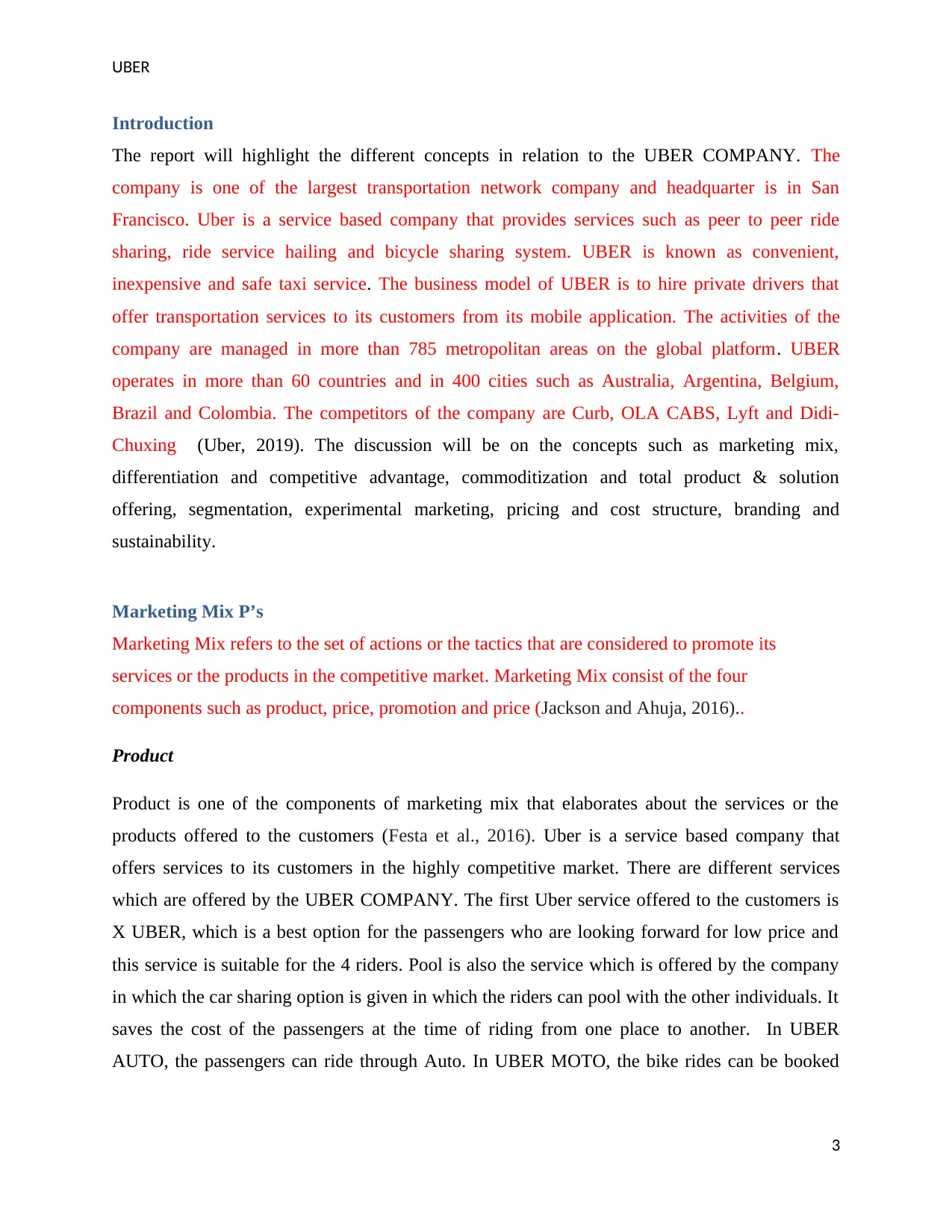
UBER
Introduction
The report will highlight the different concepts in relation to the UBER COMPANY. The
company is one of the largest transportation network company and headquarter is in San
Francisco. Uber is a service based company that provides services such as peer to peer ride
sharing, ride service hailing and bicycle sharing system. UBER is known as convenient,
inexpensive and safe taxi service. The business model of UBER is to hire private drivers that
offer transportation services to its customers from its mobile application. The activities of the
company are managed in more than 785 metropolitan areas on the global platform. UBER
operates in more than 60 countries and in 400 cities such as Australia, Argentina, Belgium,
Brazil and Colombia. The competitors of the company are Curb, OLA CABS, Lyft and Didi-
Chuxing (Uber, 2019). The discussion will be on the concepts such as marketing mix,
differentiation and competitive advantage, commoditization and total product & solution
offering, segmentation, experimental marketing, pricing and cost structure, branding and
sustainability.
Marketing Mix P’s
Marketing Mix refers to the set of actions or the tactics that are considered to promote its
services or the products in the competitive market. Marketing Mix consist of the four
components such as product, price, promotion and price (Jackson and Ahuja, 2016)..
Product
Product is one of the components of marketing mix that elaborates about the services or the
products offered to the customers (Festa et al., 2016). Uber is a service based company that
offers services to its customers in the highly competitive market. There are different services
which are offered by the UBER COMPANY. The first Uber service offered to the customers is
X UBER, which is a best option for the passengers who are looking forward for low price and
this service is suitable for the 4 riders. Pool is also the service which is offered by the company
in which the car sharing option is given in which the riders can pool with the other individuals. It
saves the cost of the passengers at the time of riding from one place to another. In UBER
AUTO, the passengers can ride through Auto. In UBER MOTO, the bike rides can be booked
3
Introduction
The report will highlight the different concepts in relation to the UBER COMPANY. The
company is one of the largest transportation network company and headquarter is in San
Francisco. Uber is a service based company that provides services such as peer to peer ride
sharing, ride service hailing and bicycle sharing system. UBER is known as convenient,
inexpensive and safe taxi service. The business model of UBER is to hire private drivers that
offer transportation services to its customers from its mobile application. The activities of the
company are managed in more than 785 metropolitan areas on the global platform. UBER
operates in more than 60 countries and in 400 cities such as Australia, Argentina, Belgium,
Brazil and Colombia. The competitors of the company are Curb, OLA CABS, Lyft and Didi-
Chuxing (Uber, 2019). The discussion will be on the concepts such as marketing mix,
differentiation and competitive advantage, commoditization and total product & solution
offering, segmentation, experimental marketing, pricing and cost structure, branding and
sustainability.
Marketing Mix P’s
Marketing Mix refers to the set of actions or the tactics that are considered to promote its
services or the products in the competitive market. Marketing Mix consist of the four
components such as product, price, promotion and price (Jackson and Ahuja, 2016)..
Product
Product is one of the components of marketing mix that elaborates about the services or the
products offered to the customers (Festa et al., 2016). Uber is a service based company that
offers services to its customers in the highly competitive market. There are different services
which are offered by the UBER COMPANY. The first Uber service offered to the customers is
X UBER, which is a best option for the passengers who are looking forward for low price and
this service is suitable for the 4 riders. Pool is also the service which is offered by the company
in which the car sharing option is given in which the riders can pool with the other individuals. It
saves the cost of the passengers at the time of riding from one place to another. In UBER
AUTO, the passengers can ride through Auto. In UBER MOTO, the bike rides can be booked
3
⊘ This is a preview!⊘
Do you want full access?
Subscribe today to unlock all pages.

Trusted by 1+ million students worldwide
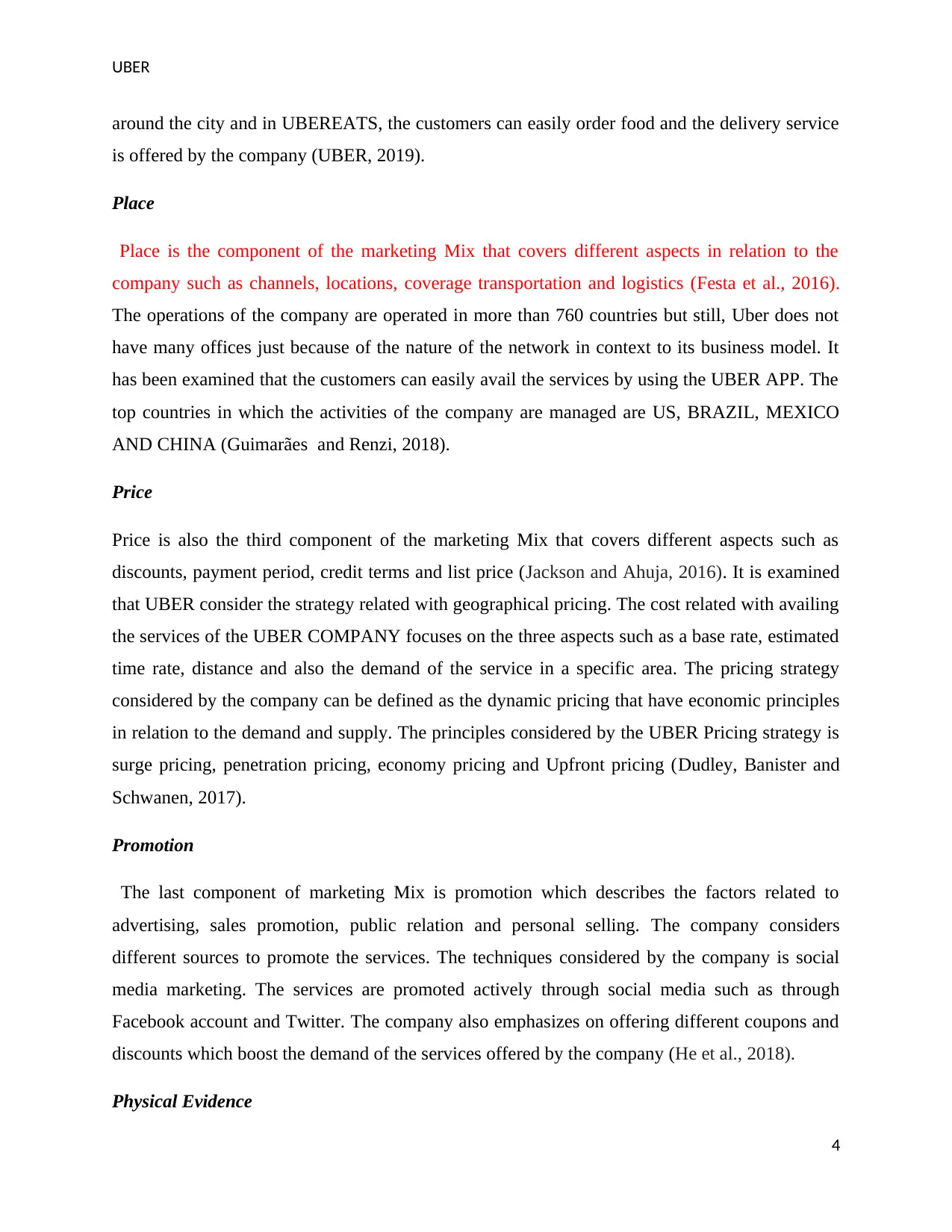
UBER
around the city and in UBEREATS, the customers can easily order food and the delivery service
is offered by the company (UBER, 2019).
Place
Place is the component of the marketing Mix that covers different aspects in relation to the
company such as channels, locations, coverage transportation and logistics (Festa et al., 2016).
The operations of the company are operated in more than 760 countries but still, Uber does not
have many offices just because of the nature of the network in context to its business model. It
has been examined that the customers can easily avail the services by using the UBER APP. The
top countries in which the activities of the company are managed are US, BRAZIL, MEXICO
AND CHINA (Guimarães and Renzi, 2018).
Price
Price is also the third component of the marketing Mix that covers different aspects such as
discounts, payment period, credit terms and list price (Jackson and Ahuja, 2016). It is examined
that UBER consider the strategy related with geographical pricing. The cost related with availing
the services of the UBER COMPANY focuses on the three aspects such as a base rate, estimated
time rate, distance and also the demand of the service in a specific area. The pricing strategy
considered by the company can be defined as the dynamic pricing that have economic principles
in relation to the demand and supply. The principles considered by the UBER Pricing strategy is
surge pricing, penetration pricing, economy pricing and Upfront pricing (Dudley, Banister and
Schwanen, 2017).
Promotion
The last component of marketing Mix is promotion which describes the factors related to
advertising, sales promotion, public relation and personal selling. The company considers
different sources to promote the services. The techniques considered by the company is social
media marketing. The services are promoted actively through social media such as through
Facebook account and Twitter. The company also emphasizes on offering different coupons and
discounts which boost the demand of the services offered by the company (He et al., 2018).
Physical Evidence
4
around the city and in UBEREATS, the customers can easily order food and the delivery service
is offered by the company (UBER, 2019).
Place
Place is the component of the marketing Mix that covers different aspects in relation to the
company such as channels, locations, coverage transportation and logistics (Festa et al., 2016).
The operations of the company are operated in more than 760 countries but still, Uber does not
have many offices just because of the nature of the network in context to its business model. It
has been examined that the customers can easily avail the services by using the UBER APP. The
top countries in which the activities of the company are managed are US, BRAZIL, MEXICO
AND CHINA (Guimarães and Renzi, 2018).
Price
Price is also the third component of the marketing Mix that covers different aspects such as
discounts, payment period, credit terms and list price (Jackson and Ahuja, 2016). It is examined
that UBER consider the strategy related with geographical pricing. The cost related with availing
the services of the UBER COMPANY focuses on the three aspects such as a base rate, estimated
time rate, distance and also the demand of the service in a specific area. The pricing strategy
considered by the company can be defined as the dynamic pricing that have economic principles
in relation to the demand and supply. The principles considered by the UBER Pricing strategy is
surge pricing, penetration pricing, economy pricing and Upfront pricing (Dudley, Banister and
Schwanen, 2017).
Promotion
The last component of marketing Mix is promotion which describes the factors related to
advertising, sales promotion, public relation and personal selling. The company considers
different sources to promote the services. The techniques considered by the company is social
media marketing. The services are promoted actively through social media such as through
Facebook account and Twitter. The company also emphasizes on offering different coupons and
discounts which boost the demand of the services offered by the company (He et al., 2018).
Physical Evidence
4
Paraphrase This Document
Need a fresh take? Get an instant paraphrase of this document with our AI Paraphraser
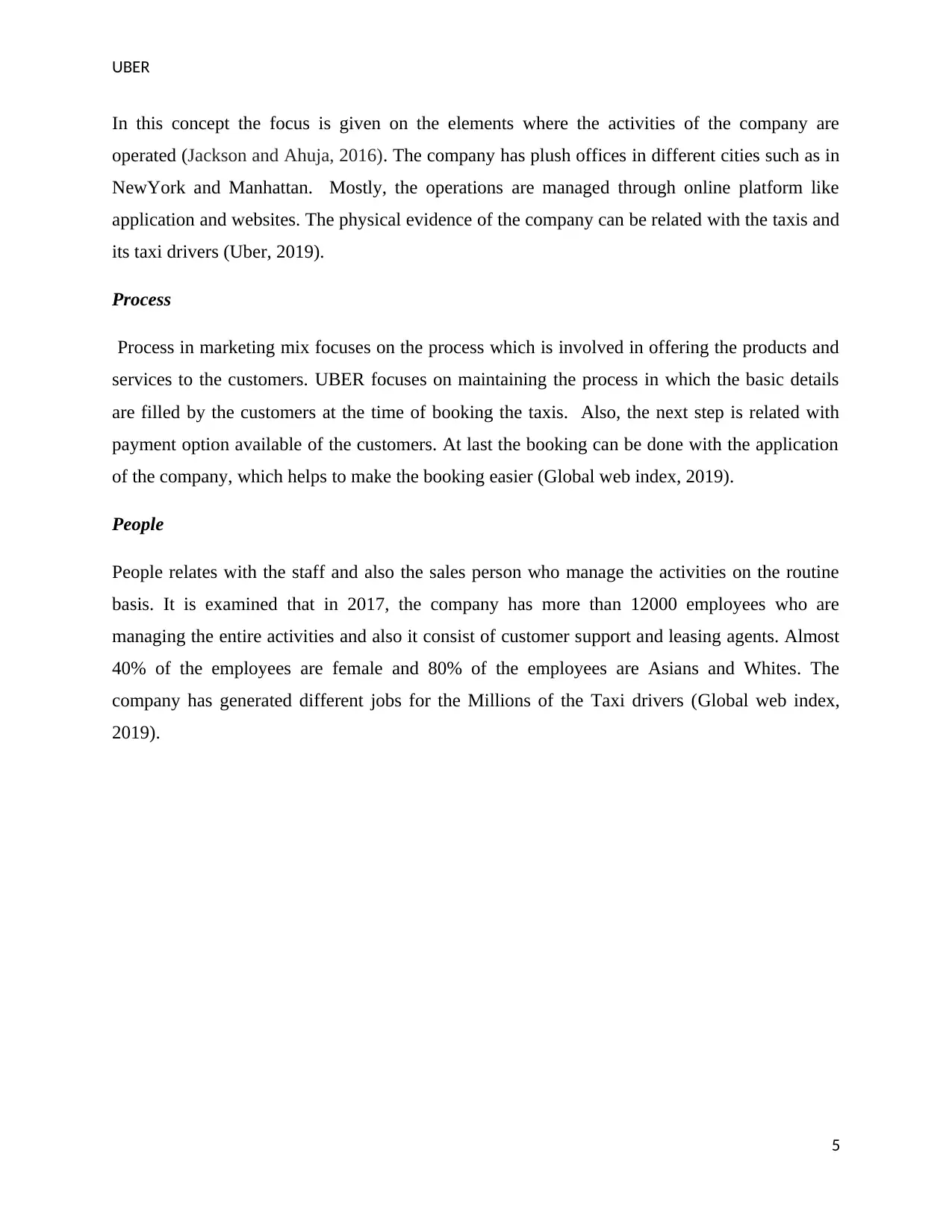
UBER
In this concept the focus is given on the elements where the activities of the company are
operated (Jackson and Ahuja, 2016). The company has plush offices in different cities such as in
NewYork and Manhattan. Mostly, the operations are managed through online platform like
application and websites. The physical evidence of the company can be related with the taxis and
its taxi drivers (Uber, 2019).
Process
Process in marketing mix focuses on the process which is involved in offering the products and
services to the customers. UBER focuses on maintaining the process in which the basic details
are filled by the customers at the time of booking the taxis. Also, the next step is related with
payment option available of the customers. At last the booking can be done with the application
of the company, which helps to make the booking easier (Global web index, 2019).
People
People relates with the staff and also the sales person who manage the activities on the routine
basis. It is examined that in 2017, the company has more than 12000 employees who are
managing the entire activities and also it consist of customer support and leasing agents. Almost
40% of the employees are female and 80% of the employees are Asians and Whites. The
company has generated different jobs for the Millions of the Taxi drivers (Global web index,
2019).
5
In this concept the focus is given on the elements where the activities of the company are
operated (Jackson and Ahuja, 2016). The company has plush offices in different cities such as in
NewYork and Manhattan. Mostly, the operations are managed through online platform like
application and websites. The physical evidence of the company can be related with the taxis and
its taxi drivers (Uber, 2019).
Process
Process in marketing mix focuses on the process which is involved in offering the products and
services to the customers. UBER focuses on maintaining the process in which the basic details
are filled by the customers at the time of booking the taxis. Also, the next step is related with
payment option available of the customers. At last the booking can be done with the application
of the company, which helps to make the booking easier (Global web index, 2019).
People
People relates with the staff and also the sales person who manage the activities on the routine
basis. It is examined that in 2017, the company has more than 12000 employees who are
managing the entire activities and also it consist of customer support and leasing agents. Almost
40% of the employees are female and 80% of the employees are Asians and Whites. The
company has generated different jobs for the Millions of the Taxi drivers (Global web index,
2019).
5
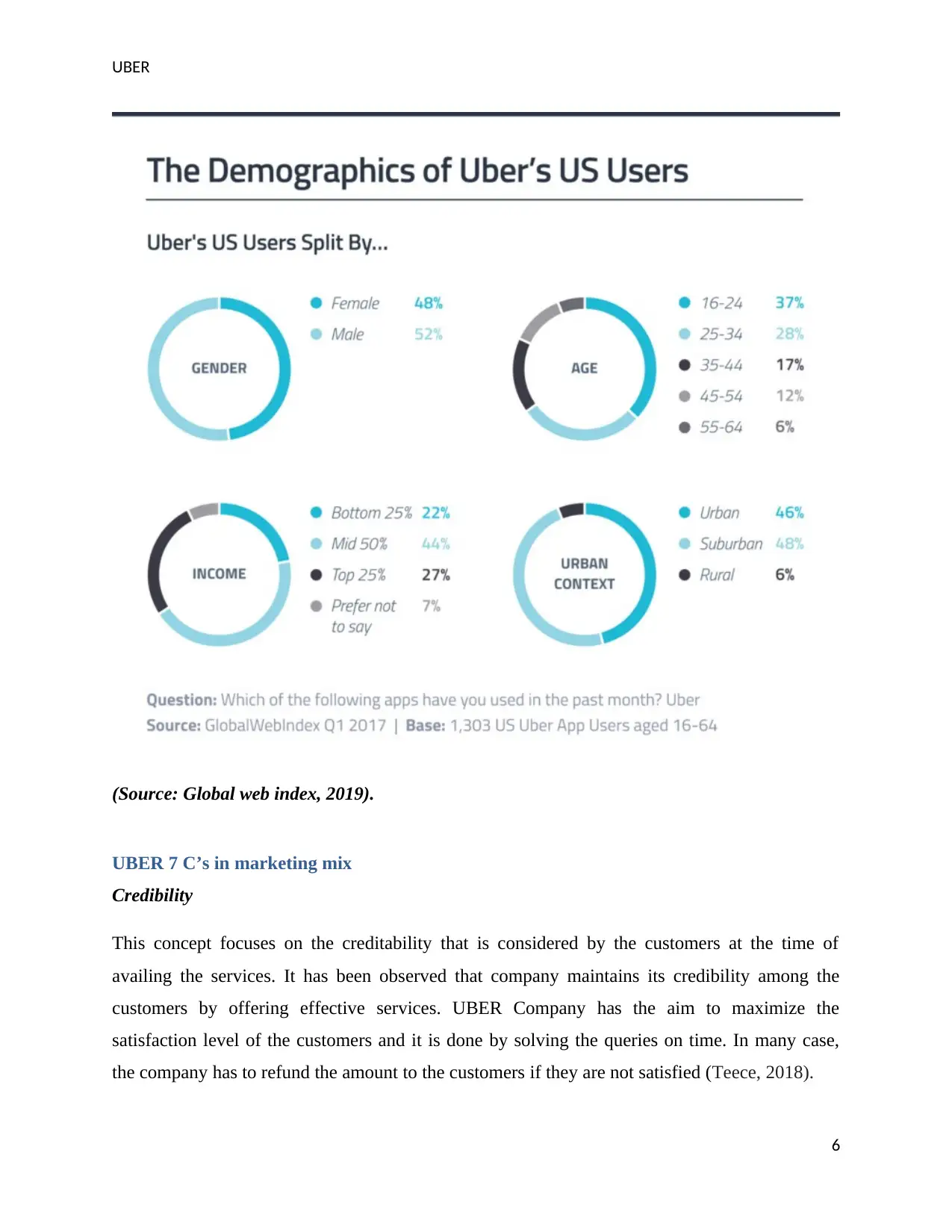
UBER
(Source: Global web index, 2019).
UBER 7 C’s in marketing mix
Credibility
This concept focuses on the creditability that is considered by the customers at the time of
availing the services. It has been observed that company maintains its credibility among the
customers by offering effective services. UBER Company has the aim to maximize the
satisfaction level of the customers and it is done by solving the queries on time. In many case,
the company has to refund the amount to the customers if they are not satisfied (Teece, 2018).
6
(Source: Global web index, 2019).
UBER 7 C’s in marketing mix
Credibility
This concept focuses on the creditability that is considered by the customers at the time of
availing the services. It has been observed that company maintains its credibility among the
customers by offering effective services. UBER Company has the aim to maximize the
satisfaction level of the customers and it is done by solving the queries on time. In many case,
the company has to refund the amount to the customers if they are not satisfied (Teece, 2018).
6
⊘ This is a preview!⊘
Do you want full access?
Subscribe today to unlock all pages.

Trusted by 1+ million students worldwide
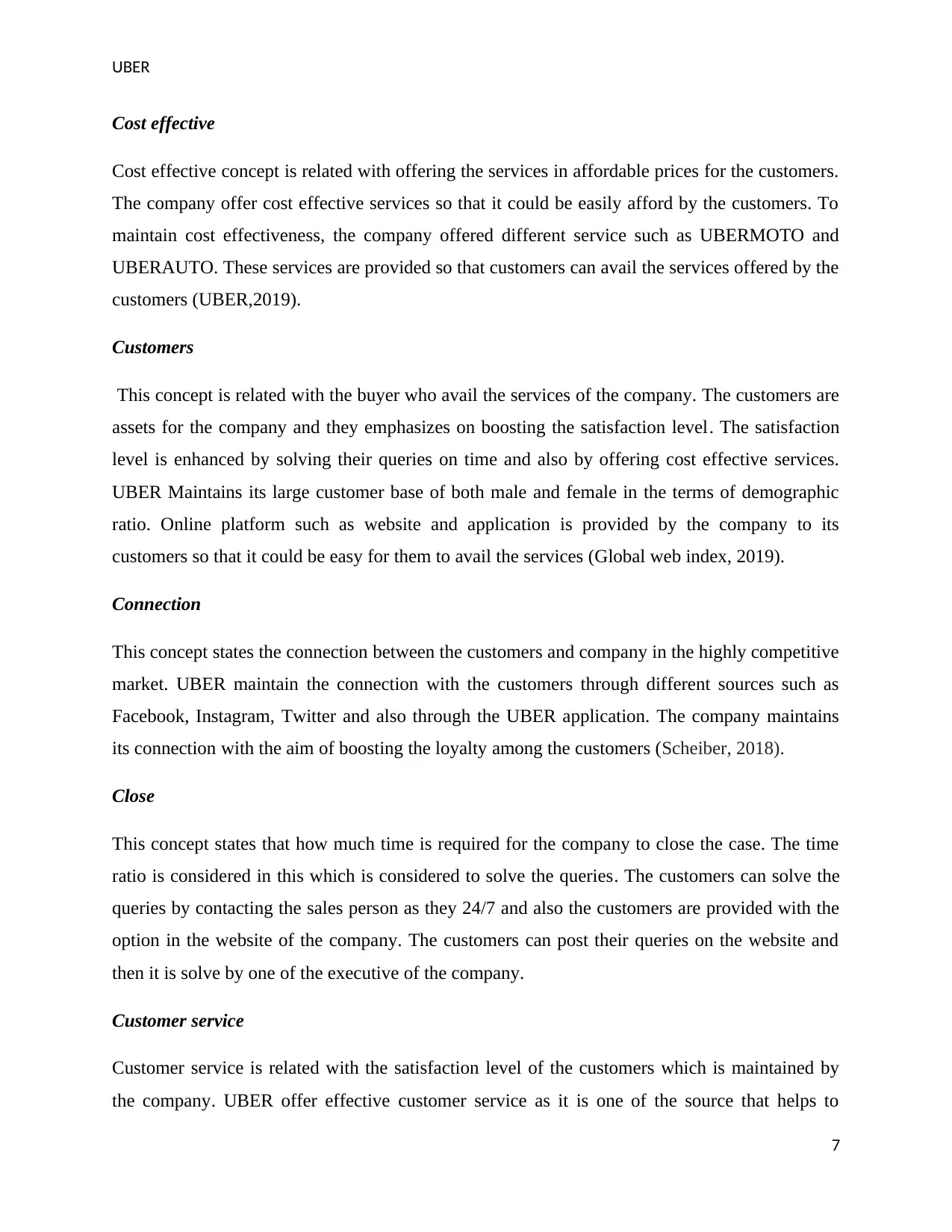
UBER
Cost effective
Cost effective concept is related with offering the services in affordable prices for the customers.
The company offer cost effective services so that it could be easily afford by the customers. To
maintain cost effectiveness, the company offered different service such as UBERMOTO and
UBERAUTO. These services are provided so that customers can avail the services offered by the
customers (UBER,2019).
Customers
This concept is related with the buyer who avail the services of the company. The customers are
assets for the company and they emphasizes on boosting the satisfaction level. The satisfaction
level is enhanced by solving their queries on time and also by offering cost effective services.
UBER Maintains its large customer base of both male and female in the terms of demographic
ratio. Online platform such as website and application is provided by the company to its
customers so that it could be easy for them to avail the services (Global web index, 2019).
Connection
This concept states the connection between the customers and company in the highly competitive
market. UBER maintain the connection with the customers through different sources such as
Facebook, Instagram, Twitter and also through the UBER application. The company maintains
its connection with the aim of boosting the loyalty among the customers (Scheiber, 2018).
Close
This concept states that how much time is required for the company to close the case. The time
ratio is considered in this which is considered to solve the queries. The customers can solve the
queries by contacting the sales person as they 24/7 and also the customers are provided with the
option in the website of the company. The customers can post their queries on the website and
then it is solve by one of the executive of the company.
Customer service
Customer service is related with the satisfaction level of the customers which is maintained by
the company. UBER offer effective customer service as it is one of the source that helps to
7
Cost effective
Cost effective concept is related with offering the services in affordable prices for the customers.
The company offer cost effective services so that it could be easily afford by the customers. To
maintain cost effectiveness, the company offered different service such as UBERMOTO and
UBERAUTO. These services are provided so that customers can avail the services offered by the
customers (UBER,2019).
Customers
This concept is related with the buyer who avail the services of the company. The customers are
assets for the company and they emphasizes on boosting the satisfaction level. The satisfaction
level is enhanced by solving their queries on time and also by offering cost effective services.
UBER Maintains its large customer base of both male and female in the terms of demographic
ratio. Online platform such as website and application is provided by the company to its
customers so that it could be easy for them to avail the services (Global web index, 2019).
Connection
This concept states the connection between the customers and company in the highly competitive
market. UBER maintain the connection with the customers through different sources such as
Facebook, Instagram, Twitter and also through the UBER application. The company maintains
its connection with the aim of boosting the loyalty among the customers (Scheiber, 2018).
Close
This concept states that how much time is required for the company to close the case. The time
ratio is considered in this which is considered to solve the queries. The customers can solve the
queries by contacting the sales person as they 24/7 and also the customers are provided with the
option in the website of the company. The customers can post their queries on the website and
then it is solve by one of the executive of the company.
Customer service
Customer service is related with the satisfaction level of the customers which is maintained by
the company. UBER offer effective customer service as it is one of the source that helps to
7
Paraphrase This Document
Need a fresh take? Get an instant paraphrase of this document with our AI Paraphraser

UBER
maximize the satisfaction level of the customers. The company has given 24/7 services to its
customers and also the option related with FAQ is provided on their website that can help to
resolve the queries of the customers (UBER, 2019).
Cash
This concept emphasizes on generating the revenue and also it is a portion related with the
growth of the company. UBER also offers the option of cash to its customers. It boosts the
demand of the services in the highly competitive market. It has been examined that UBER is one
of the service based business, so it is essential for them to offer the cash option so that customers
can avail the services easily on the global platform (Banerjee, Johari and Riquelme, 2016).
Differentiation and competitive advantage
This is one of the popular concept in which the resources and the firm capability is analyzed that
helps to maintain competitive advantage in the market (Jackson and Ahuja, 2016).. UBER
maintains its differentiation by emphasizing on offering the different services such as UBER GO,
UBER X, UBER XL and UBER POOL.
UBER GO: It is the service offered by the UBER but it is low cost service. The base
price of UBER GO is less and also the customer can book 4 seater hatchbacks with AC.
Uber X: In this the customers can book 4 seater Sedan cars with AC and the price is high
as compared to UBERGO.
UBER XL: It is an inexpensive car service in which the customers can order SUV. UBER POOL: it is a shared ride that assists in splitting the cost of the ride with the
stranger. It helps the customers to avail the services at low price.
If comparison is made with the competitors such as OLA, it is examined that company maintains
its differentiation by offering different services for every segments of the customers. Also, the
emphasis is given on maintaining the competitive advantage and it is done by collaborating with
the different car manufacturing companies. This has assisted the company to maintain its
customization of the Vehicles by having link with the different car companies. Recently, the
company collaborated with Daimler and due to this the positive impact has been analyzed on the
8
maximize the satisfaction level of the customers. The company has given 24/7 services to its
customers and also the option related with FAQ is provided on their website that can help to
resolve the queries of the customers (UBER, 2019).
Cash
This concept emphasizes on generating the revenue and also it is a portion related with the
growth of the company. UBER also offers the option of cash to its customers. It boosts the
demand of the services in the highly competitive market. It has been examined that UBER is one
of the service based business, so it is essential for them to offer the cash option so that customers
can avail the services easily on the global platform (Banerjee, Johari and Riquelme, 2016).
Differentiation and competitive advantage
This is one of the popular concept in which the resources and the firm capability is analyzed that
helps to maintain competitive advantage in the market (Jackson and Ahuja, 2016).. UBER
maintains its differentiation by emphasizing on offering the different services such as UBER GO,
UBER X, UBER XL and UBER POOL.
UBER GO: It is the service offered by the UBER but it is low cost service. The base
price of UBER GO is less and also the customer can book 4 seater hatchbacks with AC.
Uber X: In this the customers can book 4 seater Sedan cars with AC and the price is high
as compared to UBERGO.
UBER XL: It is an inexpensive car service in which the customers can order SUV. UBER POOL: it is a shared ride that assists in splitting the cost of the ride with the
stranger. It helps the customers to avail the services at low price.
If comparison is made with the competitors such as OLA, it is examined that company maintains
its differentiation by offering different services for every segments of the customers. Also, the
emphasis is given on maintaining the competitive advantage and it is done by collaborating with
the different car manufacturing companies. This has assisted the company to maintain its
customization of the Vehicles by having link with the different car companies. Recently, the
company collaborated with Daimler and due to this the positive impact has been analyzed on the
8
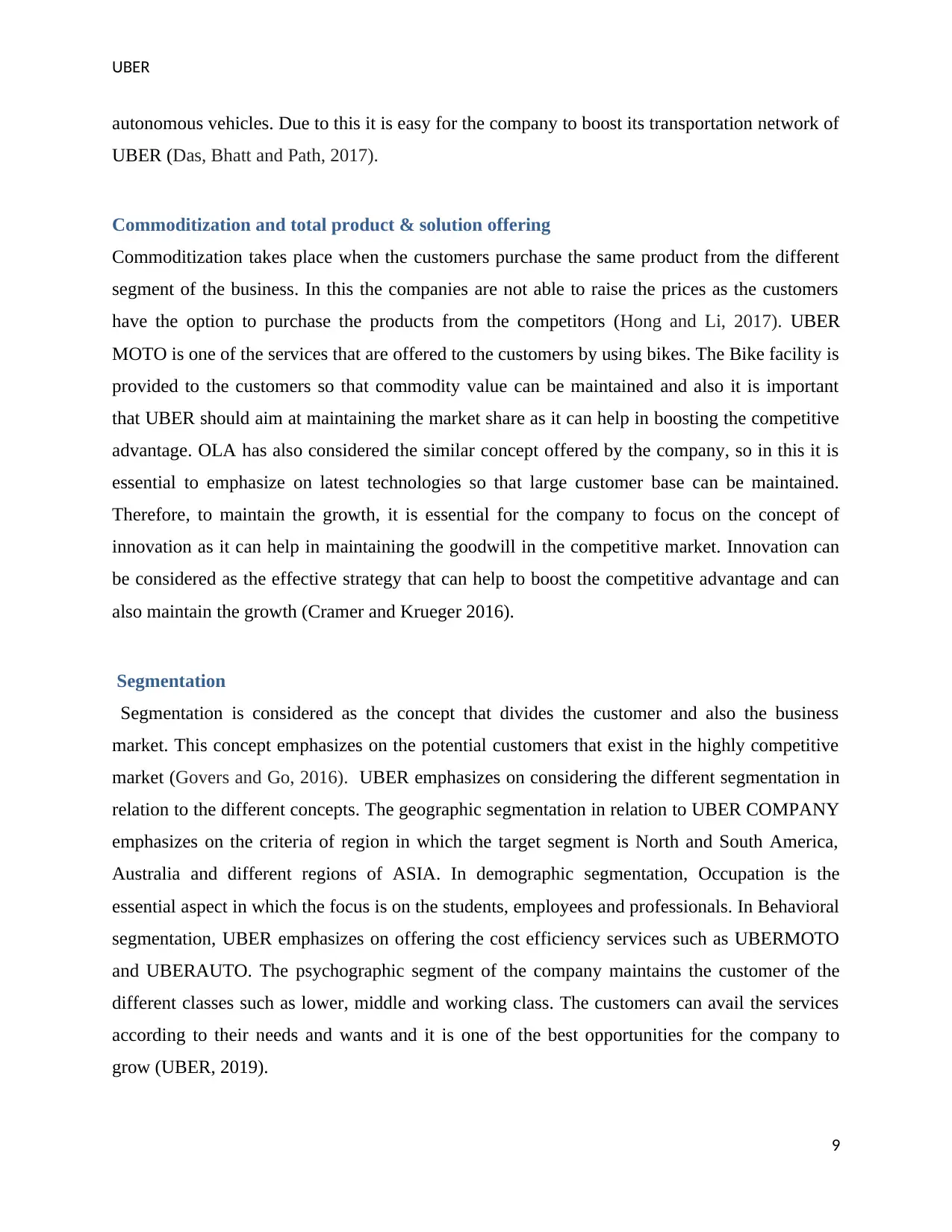
UBER
autonomous vehicles. Due to this it is easy for the company to boost its transportation network of
UBER (Das, Bhatt and Path, 2017).
Commoditization and total product & solution offering
Commoditization takes place when the customers purchase the same product from the different
segment of the business. In this the companies are not able to raise the prices as the customers
have the option to purchase the products from the competitors (Hong and Li, 2017). UBER
MOTO is one of the services that are offered to the customers by using bikes. The Bike facility is
provided to the customers so that commodity value can be maintained and also it is important
that UBER should aim at maintaining the market share as it can help in boosting the competitive
advantage. OLA has also considered the similar concept offered by the company, so in this it is
essential to emphasize on latest technologies so that large customer base can be maintained.
Therefore, to maintain the growth, it is essential for the company to focus on the concept of
innovation as it can help in maintaining the goodwill in the competitive market. Innovation can
be considered as the effective strategy that can help to boost the competitive advantage and can
also maintain the growth (Cramer and Krueger 2016).
Segmentation
Segmentation is considered as the concept that divides the customer and also the business
market. This concept emphasizes on the potential customers that exist in the highly competitive
market (Govers and Go, 2016). UBER emphasizes on considering the different segmentation in
relation to the different concepts. The geographic segmentation in relation to UBER COMPANY
emphasizes on the criteria of region in which the target segment is North and South America,
Australia and different regions of ASIA. In demographic segmentation, Occupation is the
essential aspect in which the focus is on the students, employees and professionals. In Behavioral
segmentation, UBER emphasizes on offering the cost efficiency services such as UBERMOTO
and UBERAUTO. The psychographic segment of the company maintains the customer of the
different classes such as lower, middle and working class. The customers can avail the services
according to their needs and wants and it is one of the best opportunities for the company to
grow (UBER, 2019).
9
autonomous vehicles. Due to this it is easy for the company to boost its transportation network of
UBER (Das, Bhatt and Path, 2017).
Commoditization and total product & solution offering
Commoditization takes place when the customers purchase the same product from the different
segment of the business. In this the companies are not able to raise the prices as the customers
have the option to purchase the products from the competitors (Hong and Li, 2017). UBER
MOTO is one of the services that are offered to the customers by using bikes. The Bike facility is
provided to the customers so that commodity value can be maintained and also it is important
that UBER should aim at maintaining the market share as it can help in boosting the competitive
advantage. OLA has also considered the similar concept offered by the company, so in this it is
essential to emphasize on latest technologies so that large customer base can be maintained.
Therefore, to maintain the growth, it is essential for the company to focus on the concept of
innovation as it can help in maintaining the goodwill in the competitive market. Innovation can
be considered as the effective strategy that can help to boost the competitive advantage and can
also maintain the growth (Cramer and Krueger 2016).
Segmentation
Segmentation is considered as the concept that divides the customer and also the business
market. This concept emphasizes on the potential customers that exist in the highly competitive
market (Govers and Go, 2016). UBER emphasizes on considering the different segmentation in
relation to the different concepts. The geographic segmentation in relation to UBER COMPANY
emphasizes on the criteria of region in which the target segment is North and South America,
Australia and different regions of ASIA. In demographic segmentation, Occupation is the
essential aspect in which the focus is on the students, employees and professionals. In Behavioral
segmentation, UBER emphasizes on offering the cost efficiency services such as UBERMOTO
and UBERAUTO. The psychographic segment of the company maintains the customer of the
different classes such as lower, middle and working class. The customers can avail the services
according to their needs and wants and it is one of the best opportunities for the company to
grow (UBER, 2019).
9
⊘ This is a preview!⊘
Do you want full access?
Subscribe today to unlock all pages.

Trusted by 1+ million students worldwide
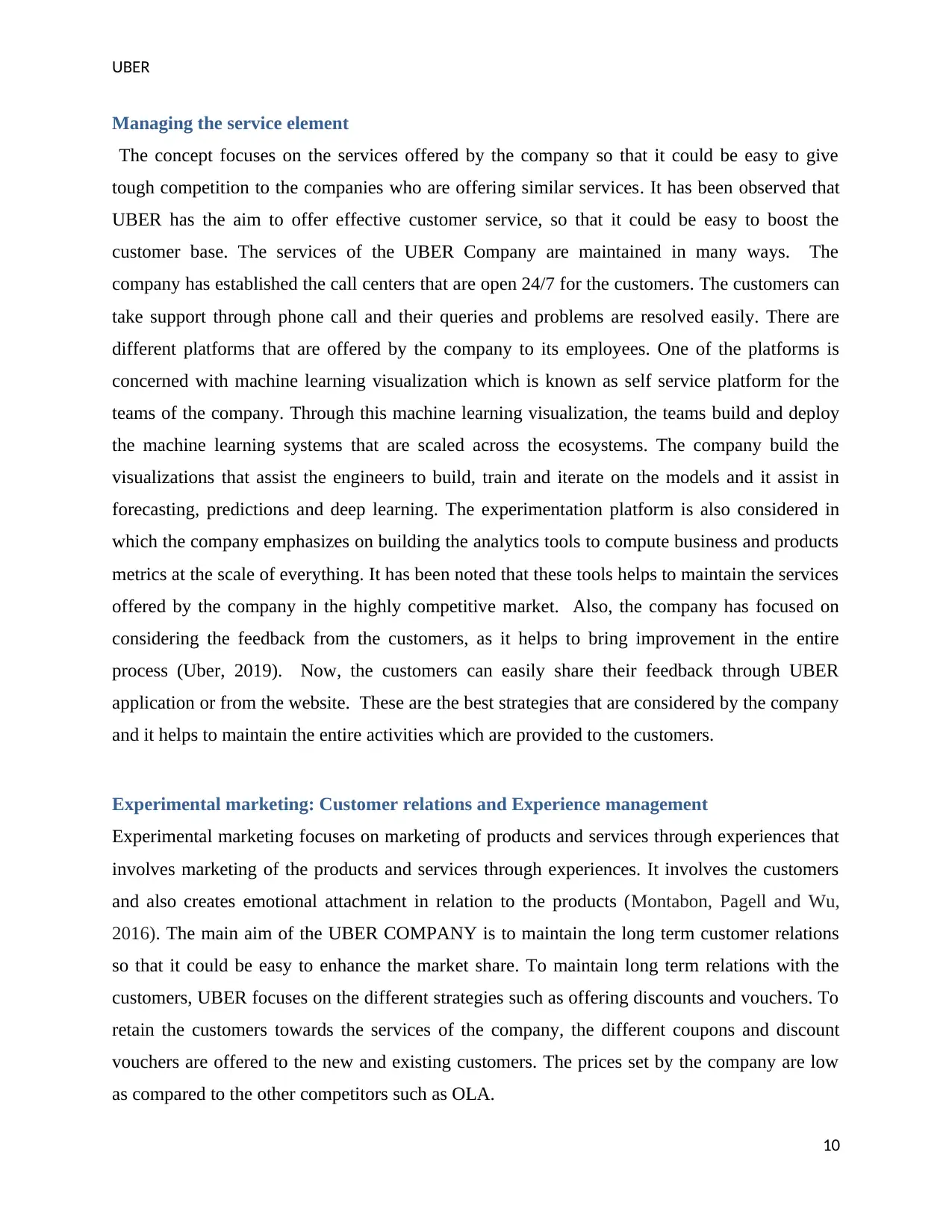
UBER
Managing the service element
The concept focuses on the services offered by the company so that it could be easy to give
tough competition to the companies who are offering similar services. It has been observed that
UBER has the aim to offer effective customer service, so that it could be easy to boost the
customer base. The services of the UBER Company are maintained in many ways. The
company has established the call centers that are open 24/7 for the customers. The customers can
take support through phone call and their queries and problems are resolved easily. There are
different platforms that are offered by the company to its employees. One of the platforms is
concerned with machine learning visualization which is known as self service platform for the
teams of the company. Through this machine learning visualization, the teams build and deploy
the machine learning systems that are scaled across the ecosystems. The company build the
visualizations that assist the engineers to build, train and iterate on the models and it assist in
forecasting, predictions and deep learning. The experimentation platform is also considered in
which the company emphasizes on building the analytics tools to compute business and products
metrics at the scale of everything. It has been noted that these tools helps to maintain the services
offered by the company in the highly competitive market. Also, the company has focused on
considering the feedback from the customers, as it helps to bring improvement in the entire
process (Uber, 2019). Now, the customers can easily share their feedback through UBER
application or from the website. These are the best strategies that are considered by the company
and it helps to maintain the entire activities which are provided to the customers.
Experimental marketing: Customer relations and Experience management
Experimental marketing focuses on marketing of products and services through experiences that
involves marketing of the products and services through experiences. It involves the customers
and also creates emotional attachment in relation to the products (Montabon, Pagell and Wu,
2016). The main aim of the UBER COMPANY is to maintain the long term customer relations
so that it could be easy to enhance the market share. To maintain long term relations with the
customers, UBER focuses on the different strategies such as offering discounts and vouchers. To
retain the customers towards the services of the company, the different coupons and discount
vouchers are offered to the new and existing customers. The prices set by the company are low
as compared to the other competitors such as OLA.
10
Managing the service element
The concept focuses on the services offered by the company so that it could be easy to give
tough competition to the companies who are offering similar services. It has been observed that
UBER has the aim to offer effective customer service, so that it could be easy to boost the
customer base. The services of the UBER Company are maintained in many ways. The
company has established the call centers that are open 24/7 for the customers. The customers can
take support through phone call and their queries and problems are resolved easily. There are
different platforms that are offered by the company to its employees. One of the platforms is
concerned with machine learning visualization which is known as self service platform for the
teams of the company. Through this machine learning visualization, the teams build and deploy
the machine learning systems that are scaled across the ecosystems. The company build the
visualizations that assist the engineers to build, train and iterate on the models and it assist in
forecasting, predictions and deep learning. The experimentation platform is also considered in
which the company emphasizes on building the analytics tools to compute business and products
metrics at the scale of everything. It has been noted that these tools helps to maintain the services
offered by the company in the highly competitive market. Also, the company has focused on
considering the feedback from the customers, as it helps to bring improvement in the entire
process (Uber, 2019). Now, the customers can easily share their feedback through UBER
application or from the website. These are the best strategies that are considered by the company
and it helps to maintain the entire activities which are provided to the customers.
Experimental marketing: Customer relations and Experience management
Experimental marketing focuses on marketing of products and services through experiences that
involves marketing of the products and services through experiences. It involves the customers
and also creates emotional attachment in relation to the products (Montabon, Pagell and Wu,
2016). The main aim of the UBER COMPANY is to maintain the long term customer relations
so that it could be easy to enhance the market share. To maintain long term relations with the
customers, UBER focuses on the different strategies such as offering discounts and vouchers. To
retain the customers towards the services of the company, the different coupons and discount
vouchers are offered to the new and existing customers. The prices set by the company are low
as compared to the other competitors such as OLA.
10
Paraphrase This Document
Need a fresh take? Get an instant paraphrase of this document with our AI Paraphraser
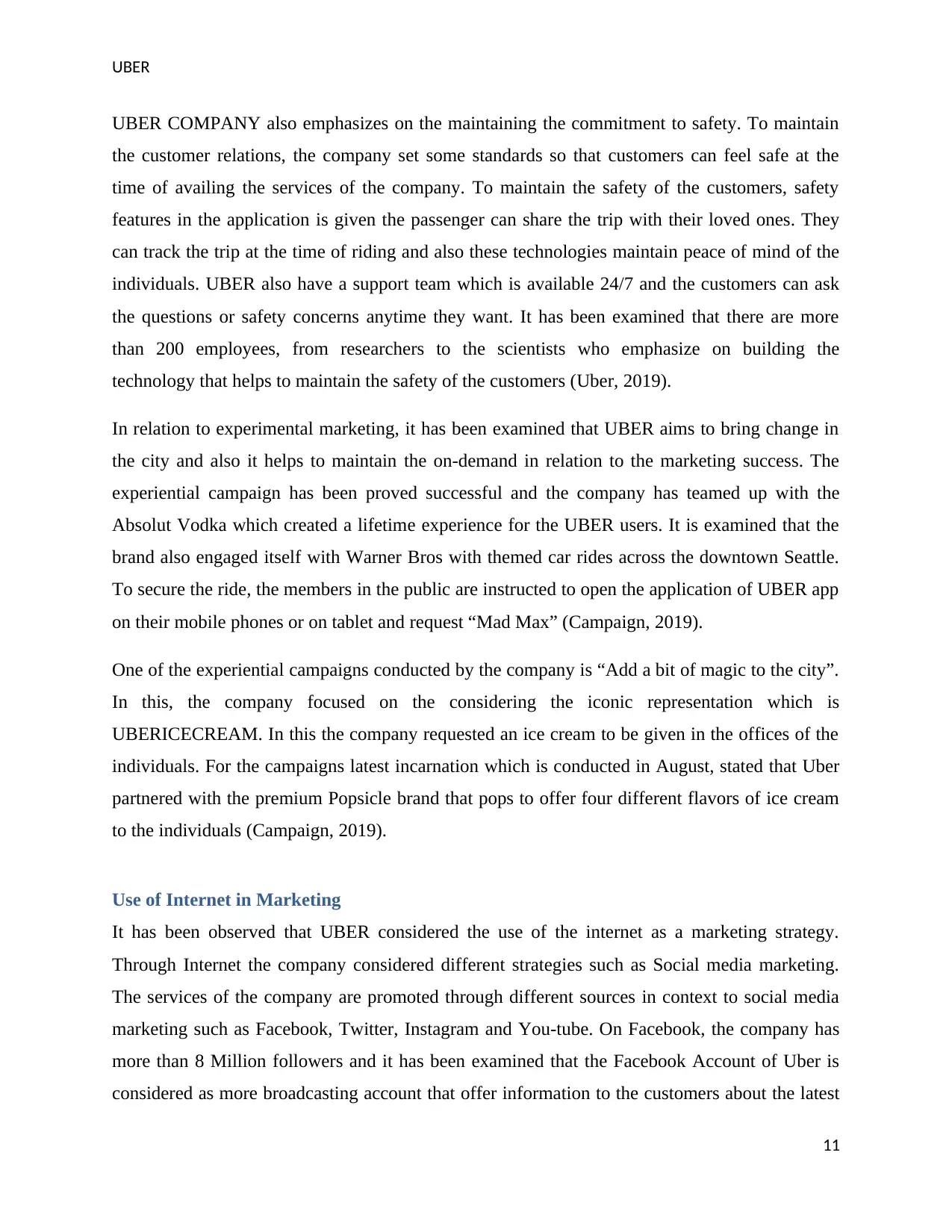
UBER
UBER COMPANY also emphasizes on the maintaining the commitment to safety. To maintain
the customer relations, the company set some standards so that customers can feel safe at the
time of availing the services of the company. To maintain the safety of the customers, safety
features in the application is given the passenger can share the trip with their loved ones. They
can track the trip at the time of riding and also these technologies maintain peace of mind of the
individuals. UBER also have a support team which is available 24/7 and the customers can ask
the questions or safety concerns anytime they want. It has been examined that there are more
than 200 employees, from researchers to the scientists who emphasize on building the
technology that helps to maintain the safety of the customers (Uber, 2019).
In relation to experimental marketing, it has been examined that UBER aims to bring change in
the city and also it helps to maintain the on-demand in relation to the marketing success. The
experiential campaign has been proved successful and the company has teamed up with the
Absolut Vodka which created a lifetime experience for the UBER users. It is examined that the
brand also engaged itself with Warner Bros with themed car rides across the downtown Seattle.
To secure the ride, the members in the public are instructed to open the application of UBER app
on their mobile phones or on tablet and request “Mad Max” (Campaign, 2019).
One of the experiential campaigns conducted by the company is “Add a bit of magic to the city”.
In this, the company focused on the considering the iconic representation which is
UBERICECREAM. In this the company requested an ice cream to be given in the offices of the
individuals. For the campaigns latest incarnation which is conducted in August, stated that Uber
partnered with the premium Popsicle brand that pops to offer four different flavors of ice cream
to the individuals (Campaign, 2019).
Use of Internet in Marketing
It has been observed that UBER considered the use of the internet as a marketing strategy.
Through Internet the company considered different strategies such as Social media marketing.
The services of the company are promoted through different sources in context to social media
marketing such as Facebook, Twitter, Instagram and You-tube. On Facebook, the company has
more than 8 Million followers and it has been examined that the Facebook Account of Uber is
considered as more broadcasting account that offer information to the customers about the latest
11
UBER COMPANY also emphasizes on the maintaining the commitment to safety. To maintain
the customer relations, the company set some standards so that customers can feel safe at the
time of availing the services of the company. To maintain the safety of the customers, safety
features in the application is given the passenger can share the trip with their loved ones. They
can track the trip at the time of riding and also these technologies maintain peace of mind of the
individuals. UBER also have a support team which is available 24/7 and the customers can ask
the questions or safety concerns anytime they want. It has been examined that there are more
than 200 employees, from researchers to the scientists who emphasize on building the
technology that helps to maintain the safety of the customers (Uber, 2019).
In relation to experimental marketing, it has been examined that UBER aims to bring change in
the city and also it helps to maintain the on-demand in relation to the marketing success. The
experiential campaign has been proved successful and the company has teamed up with the
Absolut Vodka which created a lifetime experience for the UBER users. It is examined that the
brand also engaged itself with Warner Bros with themed car rides across the downtown Seattle.
To secure the ride, the members in the public are instructed to open the application of UBER app
on their mobile phones or on tablet and request “Mad Max” (Campaign, 2019).
One of the experiential campaigns conducted by the company is “Add a bit of magic to the city”.
In this, the company focused on the considering the iconic representation which is
UBERICECREAM. In this the company requested an ice cream to be given in the offices of the
individuals. For the campaigns latest incarnation which is conducted in August, stated that Uber
partnered with the premium Popsicle brand that pops to offer four different flavors of ice cream
to the individuals (Campaign, 2019).
Use of Internet in Marketing
It has been observed that UBER considered the use of the internet as a marketing strategy.
Through Internet the company considered different strategies such as Social media marketing.
The services of the company are promoted through different sources in context to social media
marketing such as Facebook, Twitter, Instagram and You-tube. On Facebook, the company has
more than 8 Million followers and it has been examined that the Facebook Account of Uber is
considered as more broadcasting account that offer information to the customers about the latest
11

UBER
deals and offers. UBER offers deals, discounts and new rides coupons through its Facebook
account. Through Facebook, the company also addresses the complaints of the customers and the
management emphasizes on solving the queries of the customers. Through social media, it can be
easy for the company to solve the queries of the customers and also it is a platform that can help
in attaining the large market share in the competitive market. Social media for Uber is a platform
which is assisting to shape the smarter world in the field of marketing and also through this
UBER is able to attain the positive results (Pratap, 2019).
Twitter is also the platform that is used with the help of internet in the field of marketing. It is
observed that the company has 698K followers on Twitter. The followers are informed through
this medium about the deals and coupons offered by the company. The next social media
platform is Instagram through which the marketer tries to maintain the deep reach with the
customers. In the present scenario, the company has shared approximately 477 images with its
followers in the Instagram account. These are the sources that are used by the company in
relation to the strategies of marketing. This has helped the company to maintain the large market
share and boosted the satisfaction level of the customers (Pratap, 2019).
For marketing, the company also have the video sharing site through which marketing of the
services are done that directly deepen the connection with the customers. UBER’S YouTube
account has more than 88,500 followers that have 989 videos posted and it has gathered 40
Million views. This is one of the effective strategies that assisted to engage the customers in an
effective manner. New videos are posted by the company which helps in attracting the new
customers towards the services offered in the market. So, by considering these concepts the
company considered the use of internet as a marketing source (Pratap, 2019).
Pricing and Cost Structure
Cost structure related with the type of proportions of fixed and variable costs that is considered
by the business. This concept is also known as the management accounting concept. The pricing
and cost structure of the company is designed according to the city (Chen, Peng, Liu and Zhao,
2017). Depending on the city the cost of the rides are set and calculated. There are two type of
pricing considered by the company. The first is up front fares, in which upfront pricing is
considered and the exact price is given before requesting the ride.
12
deals and offers. UBER offers deals, discounts and new rides coupons through its Facebook
account. Through Facebook, the company also addresses the complaints of the customers and the
management emphasizes on solving the queries of the customers. Through social media, it can be
easy for the company to solve the queries of the customers and also it is a platform that can help
in attaining the large market share in the competitive market. Social media for Uber is a platform
which is assisting to shape the smarter world in the field of marketing and also through this
UBER is able to attain the positive results (Pratap, 2019).
Twitter is also the platform that is used with the help of internet in the field of marketing. It is
observed that the company has 698K followers on Twitter. The followers are informed through
this medium about the deals and coupons offered by the company. The next social media
platform is Instagram through which the marketer tries to maintain the deep reach with the
customers. In the present scenario, the company has shared approximately 477 images with its
followers in the Instagram account. These are the sources that are used by the company in
relation to the strategies of marketing. This has helped the company to maintain the large market
share and boosted the satisfaction level of the customers (Pratap, 2019).
For marketing, the company also have the video sharing site through which marketing of the
services are done that directly deepen the connection with the customers. UBER’S YouTube
account has more than 88,500 followers that have 989 videos posted and it has gathered 40
Million views. This is one of the effective strategies that assisted to engage the customers in an
effective manner. New videos are posted by the company which helps in attracting the new
customers towards the services offered in the market. So, by considering these concepts the
company considered the use of internet as a marketing source (Pratap, 2019).
Pricing and Cost Structure
Cost structure related with the type of proportions of fixed and variable costs that is considered
by the business. This concept is also known as the management accounting concept. The pricing
and cost structure of the company is designed according to the city (Chen, Peng, Liu and Zhao,
2017). Depending on the city the cost of the rides are set and calculated. There are two type of
pricing considered by the company. The first is up front fares, in which upfront pricing is
considered and the exact price is given before requesting the ride.
12
⊘ This is a preview!⊘
Do you want full access?
Subscribe today to unlock all pages.

Trusted by 1+ million students worldwide
1 out of 18